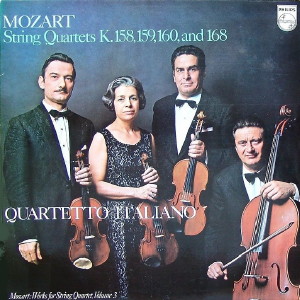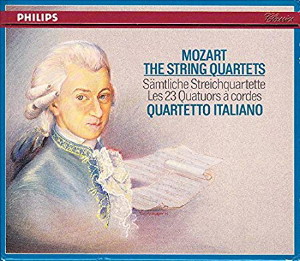 |
|
Philips
- 1 LP - 6500 172 - (p) 1972
|
 |
| Philips
- 8 CDs - 416 419-2 - (c) 1990 |
|
| Wolfgang Amadeus
Mozart (1756-1791) |
|
|
|
|
|
|
|
| String
Quartet No. 5 in F major, KV 158 |
|
11' 32" |
|
| -
Allegro |
3' 28" |
|
|
-
Andante un poco allegretto
|
5' 45" |
|
|
| -
Tempo di menuetto |
6' 19" |
|
|
|
|
|
|
| String
Quartet No. 6 in B flat major, KV
159 |
|
13' 13" |
|
-
Andante
|
5' 27" |
|
|
| -
Allegro |
5' 14" |
|
|
| -
Rondo (Allegro grazioso) |
2' 32" |
|
|
|
|
|
|
| String
Quartet No. 7 in E flat major, KV
160 |
|
11' 04" |
|
| -
Allegro |
3' 11" |
|
|
-
Un poco adagio
|
5' 13" |
|
|
| -
Presto |
2' 40" |
|
|
|
|
|
|
| String
Quartet No. 8 in F major, KV 168 |
|
14' 35" |
|
| -
Allegro |
4' 21" |
|
|
| -
Andante |
5' 34" |
|
|
| -
Menuetto |
2' 34" |
|
|
| -
Allegro |
2' 06" |
|
|
|
|
|
|
QUARTETTO ITALIANO
- Paolo Borciani, Elisa Pegreffi, violino
- Piero Farulli,
viola
- Franco Rossi, violoncello
|
|
|
|
|
|
Luogo e data
di registrazione |
|
La-Tour-de-Peilz
(Svizzera)
- 31
agosto / 2 settembre
1971 |
|
|
Registrazione: live
/ studio |
|
studio |
|
|
Producer / Engineer |
|
Vittorio
Negri
|
|
|
Prima Edizione LP |
|
Philips | 6500
172
| 1
LP | (p) 1972
|
|
|
Prima Edizione CD |
|
Philips | 416 419-2
| 8
CDs - (1°,
15-17; 2°,
1-3, 4-6, 7-10) | (c)
1990 | ADD
|
|
|
Note |
|
-
|
|
|
|
|
When Haydn
and Mozart first began
to write string quartets,
the form and patterns of
such works were by no
means settled - indeed,
many of theyr early
quartets sound at least
as well on a full string
orchestra as they do
when played by a small
chamber group. The
number of movements, too
was fluid, ranging from
a mere two to five or
six, including perhaps a
couple of minuets with
their attendant trios.
Haydn did a great deal
to settle the ultimate
four-movement form of
the classical string
quartet, and his young
friend Mozart trod
closely in his
footsteps; but, being
on the whole a
more cosmopolitan,
"travelled" person,
young Mozart was
subjected to many more
external influences than
was Haydn, more or
less shut off from
the world in the
smaller cosmos of
the Esterházys.
Mozart,
coming into the
musical fray a
little later than
Haydn or his
beloved J. C.
Bach, immediately
adopted what we
call "sonata form"
- a term quite
unknown to the
composers of the
time, and not even
described in
textbook terms
until after
Mozart's death.
But he was a very
impressionable
youngster, too
trying hard to be
worldly-wise, and
so in Italy
his quartets took on
an Italianate
quality, and in
Austria they
followed Germanic
patterns. So three
of the four quartets
recorded here are in
the Italianate,
three-movement form,
and one follows the
Germanic,
four-movement
pattern. And he
himself, of course,
was developing very
rapidly all the time
as a composer. It is
fascinating to
observe hus
marvellous young
musical mind
expanding, within
the space of a few
months, as revealed
in these four
charming quartets.
Yet even so, each
work is perfection
within itself and
within its own terms
- one would not wish
to alter a single
note.
QUARTET
IN F, K. 158
Written
in the winter of
1772-73, in
Milan, where the
youthful Mozart
had gone to
compose and
direct his opera
seria,
"Lucio Silla,"
this is the
earliest of
these four
quartets. But
what in
extraordinary
young man (and
composer) Mozart
was; to us, his
music seems all
clarity and
light, but to
his
contemporaries
it often proved
very difficult
and hard to
understand. We
can perhaps
comprehend their
dilemma a little
in this very
quartet. In less
than two bars in
the first
movement Mozart
has sharpened
his tonic note
of F and gone
into G minor -
the most extreme
of transitions
to an eighteenth-century
music-lover.
And so he goes
on, no doubt
causing his
contemporary
hearers extreme
aural
tribulation -
they weren't
used to
composers
"crashing
their gears"
in this unusual
fashion. Yet
Mozart
disguises such
freakishness
to some extent
with his
outstanding
melodic
facility. This
movement is in
3/4 time,
familiar in so
many operatic
sinfonie,
from Hasse
oawards, yet
the opening
motif is so
seductively
original, with
its elegant
triplets that
the listener
forgets the
outre
harmonies and
is won over
immediately;
melody succeds
melody, with
the triplet
rhythm
continually
asserting
itself. after
the double bar
(and optional
repeat) there
is a
development
section of
nearly 30 bars
- quite long
for Mozart,
who unlike
Haydn loved
tunes more
than their,
development.
Then comes the
recapitulation
and, at the
end, a brief
coda based on
the main
subject.
The
slow movement
in A minor,
starts as a
"canon at the
octave," that
is to say the
various
instrumental
voices enter
one after the
other an
octave apart.
Then having
shown his
"scence,"
Mozart seduces
our ears
with some of
his inimitable
melodies on
the first
violin, with
the other
instruments
murmuring an
accompaniment.
After a brief
development,
the canonic
subject
reappears, and
so we move to
the end - what
is so
remarkable is
the way in
which the
young composer
combines
"learnèd"
counterpoint
with galant
melody, and
brings off the
two so
superbly.
For
his finale,
Mozart writes
a minuet and
trio. But what
a minuet - all
chromatic
inflection,
plus a very
bold unison
passage in its
second strain,
just after the
double bar,
and with
several of
those
Scotch-snap
rhythms, wich
were to become
so
characteristic
and
essentially
Mozartian,
within the
minuet
framework. The
trio section
is in F minor,
but again much
inflected
until some
bright runs on
the first
violin bring
us back to F
minor and the
repeat of the
minuet.
QUARTET
IN B FLAT, K.
159
This
charming work
was written in
Milan in the
early months
of 1773. Like
many Italian
works of the
period, it
opens with a
serene slow
movement, full
of characteristic
Mozartian
turns of
melody. This opening
movement is
based on
"sonata" form,
with double
bars and
repeat signs
for each of
its two
sections. As
usual with
Mozart,
the
development
section is
comparatively
brief - a mere
15 bars.
The
second
movement is
one of the
earliest
examples of
Mozart's use
of the
agitated key
of G minor -
his "key of
fate" which
was to mean so
much to him in
later years.
His first
well-known use
ot it is in
his first G
minor
symphony, K.
183, dating
from just a
little later
than this
quartet but,
already, there
is no lack of
fire and
passion in
this intense
quartet
movement in
3/4 time. It
is also one of
the longest of
his early
chamber-music
movements -
195 bars in
all, without
repeats. After
the fire and
passion the
finale is a
gracious quick
gavotte, the
main theme
being
announced in
the first
eight bars.
QUARTET
IN E FLAT, K.
160 (EINSTEIN
159A)
Begun
in Milan in
1773, and
probably
finished back
home in
Salzburg a
little later,
this is one of
the gayest,
happiest, and
most
Italianate of
Mozart's early
works, rather
like a little
sinfonia
for strings -
the mystery is
that it has
never become
as well-known
as, say the
divertimenti
K. 136-138.
The first
movement is
packed with
sparkling
tunes, as
"Mozartian" as
any one could
wish, and
brilliantly
instrumented.
It is in full
sonata form,
with a brief
development
section of
only 14 bars,
but, with so
many gorgeous
tunes, who
cares about
their
development?
The slow
movement is in
a terser kind
of sonata
form, based on
some very
eloquent,
sighing
subjects. Then
comes a lively
2/4 Presto,
which begins
as a march and
turns into a
jig, and is
most
exhilarating.
What a superb
little work
this quartet
is - one
wonders if
those
eighteenth-century
amateurs
appreciated it
for what it
was wearth.
QUARTET
IN F, K. 168
From
Milan, we turn
to Vienna, in
the August of
that same busy
year of 1773.
Mozart began a
group of six
string
quartets,
obviously with
a view to
their
publication as
a set, but the
music-sellers
asvertised
them only as
being "fairly
and clearly
written" - not
printed or
engraved;
Mozart had
much less
success with
publishers
than many
lesser men.
The
two male
Mozarts, Papa
Leopold and
son Wolfgang,
had gone to
Vienna in the
trail of their
unbeloved
patron, the
Archbishop of
Salzburg, no doubt
in the hope of
finding at
least the
promise of
some position
for young
Wolfgang and
the chance of
deliverance
from slavery
of father
Leopold.
Alas, their
journey was
in vain;
apart from
joyful
meetings with
various old
friends and
the
performance of
some of
Wolfgang's
works, they
gained little
from their
request, and
Papa Mozart
even grumbled
at being out
of pocket over
the jaunt.
Vienna was in
a turmoil over
the proposed
suspension of
the order of
the Jesuits
and the
confiscation
of their rich
properties -
the resultant
unsettled
atmosphere was
hardly
conducive to
joyful
music-making,
for these same
Jesuits bad
been ready
supporters of
music. Writing
home to Frau
Mozart, in
Salzburg, Papa
Leopold had
said: "Things
must and will
mend; take
courage, God
will hel us."
So he and
young Wolfgang
soldiered on,
the Latter
with this
first of a
proposed set
of
half-a-dozen
string
quartets.
The
work is very
much in the
Austrian
style, with
more emphasis
placed on
development
than in the
carefree
Italianate
quartets of a
few months
earlier. In
addition the
texture is
also more
contrapuntal,
in true
chamber-music
style. The
sonata-form
first movement
has a
development
section of 21
bars, while
the music
itself is very
chromatic in
texture. The
slow movement
(in F minor
and marked to
be played with
muted strings)
is in canonic
form, an
ancient
contrapuntal
style of
writing at
which Mozart
liked to try
his hand every
now and then;
this example
opens fairly
strictly, as
in the slow
movement of K.
158, with a
canon at the
octave - but
it abandons
strict canon
after a while,
although the
counterpoint
itself is
beautifully
maintained. A
particularly
gay minuet
follows, with
a gracious
trio (which
still gives a
deferential
nod to strict
counterpoint
and canon). In
the finale,
canon turns
into fugue -
and a very
lively fugue
at that - in
the gayest 2/4
time; a
tremendous
unison passage
brings this
fascinating
quartet to a
hilarious
conclusion.
Charles
Cudworth
|
|
|